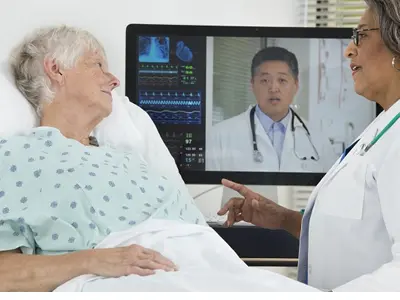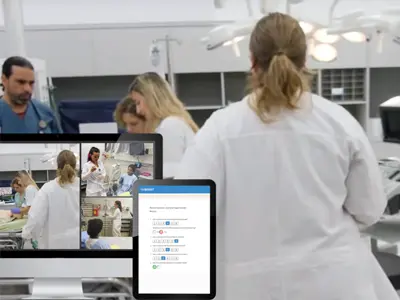What is the future of Hospital Audio Visual solutions?
Table of Contents

The healthcare industry has been rapidly evolving over the years. As the world becomes more technologically advanced, healthcare institutions are finding new ways to improve patient care and streamline their operations.
Audio visual (AV) solutions are playing a significant role in this transformation. They are enabling hospitals to enhance patient experiences, improve communication and provide better healthcare services. In this article, we will explore the future of hospital audio visual solutions and their potential impact on the healthcare industry.
AV solutions in healthcare are not new. Hospitals have been using AV technology for years. They use it to train medical students, conduct virtual consultations and communicate important information to staff and patients. However, with the rise of new technologies, such as virtual reality (VR), augmented reality (AR), and artificial intelligence (AI), the possibilities for AV solutions in healthcare are growing exponentially.
One area where AV solutions are making a significant impact is in patient experience.
Hospitals are investing in AV technologies to improve the quality of patient care and enhance the overall patient experience. For example, interactive displays in patient rooms can provide patients with real-time access to their medical records, treatment plans, and care team information. This technology can help patients feel more informed and involved in their healthcare, leading to better outcomes and higher patient satisfaction rates.
Moreover, AV solutions can also help reduce patient anxiety and stress levels, which can have a positive impact on their recovery. For example, virtual reality headsets can be used to transport patients to calming and relaxing environments, such as a beach or forest, which can help alleviate their anxiety and promote relaxation.

Another area where AV solutions are making a significant impact is in medical training and education.
Hospitals are using AV technology to provide medical students and residents with immersive and interactive training experiences. For example, VR and AR technologies can simulate medical procedures and allow trainees to practice and develop their skills in a safe and controlled environment.
Furthermore, AV solutions can also improve communication and collaboration among healthcare providers. Video conferencing systems, for example, can enable healthcare providers to communicate and collaborate in real-time, regardless of their physical location. This technology can help streamline operations, reduce errors, and improve patient outcomes.

In the future, we can expect to see even more advanced AV solutions in healthcare.
For example, AI-powered diagnostic tools can help healthcare providers identify medical conditions and develop personalized treatment plans for patients. These tools can also help healthcare providers monitor patient health in real-time and alert them to potential health risks before they become serious.
Moreover, as remote healthcare becomes increasingly popular, we can expect to see more advanced AV technologies that enable virtual consultations and telemedicine. With the help of AV technology, patients will be able to connect with their healthcare providers from anywhere in the world, making healthcare more accessible and convenient.

Another exciting development in the future of AV solutions in healthcare is the use of robots
Robots can be used to perform a variety of tasks, such as delivering medication and supplies, assisting with patient mobility, and even conducting surgical procedures. As the technology becomes more advanced, we can expect to see even more applications for robotics in healthcare.
However, as with any technology, there are challenges and concerns that must be addressed. One major concern is data privacy and security. Hospitals must ensure that patient data is protected and secure, and that AV solutions comply with data privacy regulations such as HIPAA.

Another concern is the potential for technology to create a divide between patients and healthcare providers. While AV solutions can enhance patient experiences and improve communication, they cannot replace the human touch and connection that is vital in healthcare. Therefore, it is important to strike a balance between technology and human interaction to ensure that patients receive the best possible care.
In conclusion, AV solutions are transforming the healthcare industry in many ways. From improving patient experiences to enhancing medical training and education, AV technologies are helping hospitals provide better care and improve patient outcomes.
Audio visual (AV) solutions are playing a significant role in this transformation. They enable hospitals to enhance patient experiences, improve communication, and provide better healthcare services.
Others also read the following article
Want to know more about the Audio Visual Solutions?
